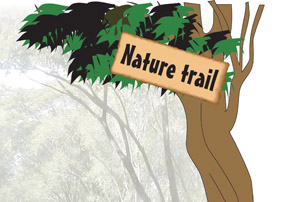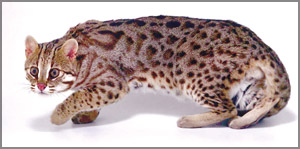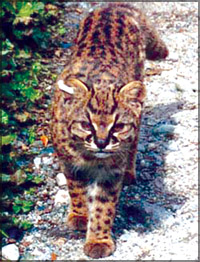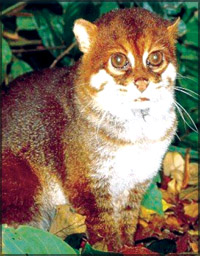
Felines: Small, wild and beautiful - VI:
A trio in need of protection
More than ten members of the fascinating cat family have been
introduced to you through Nature Trail these past few weeks. We
certainly hope you enjoyed learning about these furry friends, cousins
of your very own pet cat, living in the wild. Today too we bring you
interesting facts about another three species of small, wild cats.
Leopard cat
Found mostly in the South East region of the world, the leopard cat (Prionailurus
bengalensis) is as large as a domestic cat and has even been interbred
with the domestic cat to create the Bengal cat. Nine sub species are
known.
There are considerable differences in size from region to region. In
Indonesia, the average size is 45 cm (18 in) plus a 20 cm (8 in) tail.
In the Amur region it is 60 cm in length with a 40 cm tail. On average,
the shoulder height is about 40 cm (16 in) and the weight is 4.5-6.8 kg
(10-15 lbs).
|

A skillful tree climber |
The colouration of the fur too is variable. The fur is generally
yellow in the cats found in the southern region while it is a
silver-grey in the cat population living in the northern areas.
The chest and lower parts of the head are white. It bears black
markings, spots or resottes, depending on the species. The brown to
black markings on the body blend into stripes at the top of the back.
It has a large white spot on the back of the otherwise black ears.
Thin stripe markings are found on the top and side of the head.
Not much is known about the social behaviour and habits of this wild
cat even though it has one of the widest spread ranges of any Asian
species of wild cat. It is found all across South East Asia to the east
and down through Java, Borneo to the central Philippine Islands.
Like most members of the cat family, the leopard cat too is known to
be a nocturnal creature. It hunts hares, birds, rodents and other small
mammals including bats. A skillful tree climber, the leopard cat also
has the ability to swim even though it seldom does so.
Well, don't you think it's interesting that this member of the cat
family is a good swimmer, because, a majority of domestic cats generally
don't like water. Of course, there are some cats who enjoy a 'bath' even
though they may not go swimming!
Usually a solitary animal like most of the other small wild cats, the
leopard cat likes to live in forests and rainforests in low and
mountainous areas which are not arid. The female gives birth to a litter
of 2-4 kittens after a gestation period of 65-70 days.
Its lifespan is about 10-15 years. In Hong Kong it is a protected
species. Even though the population is well over 50,000 it is on the
decline due to loss of habitat and hunting.
Kodkod
Found only in Chilie and Argentina in the Andese Mountains, the
kodkod (Leopardus guitna), also known as codcod is an extremely rare and
elusive animal.
|

The kodkod is considered to be the smallest cat in the western
hemisphere. |
 According to local myth, it was once believed that the kodkod was a
vampire because of the punctured marks it left on its prey, similar to
the markings left by the vampire bat. According to local myth, it was once believed that the kodkod was a
vampire because of the punctured marks it left on its prey, similar to
the markings left by the vampire bat.
However, once it was discovered that the kodkod was not a blood
sucking animal, the very people who once hunted the cat had become its
protectors. Two sub species have been recognised.
This shy, member of the cat family doesn't adapt well to areas
disturbed by humans. Its habitats are mostly countryside and wooded
areas, but habitat loss has become a threat to the animal's existence.
It is considered to be the smallest cat in the western hemisphere.
Smaller than a house cat, and similar in size to the black footed cat
and rusty spotted cat, the kodkod's average weight is around 2.2 kg.
Its typical length is 50-60 cm and the shoulder height is 25 cm. The
fur coat is yellow brown to reddish brown with dark spots. Full black
cats are not uncommon. Dark spotting marks which often continue onto the
feet are common among kodkods.
The tail is marked with 10-12 dark bands which widen at the tip, like
in the Andean mountain cats. It has white eyespots on the back of its
black ears. Black bands could also be seen on the chest area.
An unusual feature is its disproportionately large claws. It is not
known as to why this cat has such big claws, but researchers are of the
view it could be to climb difficult trees or to catch a particular type
of prey. Generally kodkods are known to prey on small mammals like
rodents, birds, small reptiles and even poultry.
The females give birth to 1-3 kittens after a gestation period of
72-73 days.
Like the other two wild cats featured here today the kodkod too is
vulnerable and needs to be protected from becoming extinct.
Flat headed cat
Perhaps you are already pondering over the name of the animal
because, generally cats have roundish heads and certainly not flat ones.
Well the reason this particular species is so named is because it has a
long, sloping snout and the top of the skull is somewhat flattened.
 This and a few other features have led to the flat headed cat (Prionailurus
planiceps) being branded as a unique and unusual member of the cat
family. It not only has teeth which are all pointed, (while in other
cats its only the canines that are pointed), but also claws that cannot
be retracted into their protective sheaths. This and a few other features have led to the flat headed cat (Prionailurus
planiceps) being branded as a unique and unusual member of the cat
family. It not only has teeth which are all pointed, (while in other
cats its only the canines that are pointed), but also claws that cannot
be retracted into their protective sheaths.
In fact, it is one of four cats not able to retract its claws, the
other being the cheetah, fishing cat, and the irimote cat. Its claws can
be seen at all times, but they do not rub against the ground when
walking like the cheetah's claws. It has webbed feet and the pads are
long and narrow.
The cat's appearance is set apart from what is expected from other
members of the cat family by the shape of its head and also the short,
stubby legs, small round ears set very low on the side of the skull,
large eyes which are close set allowing for maximum binocular vision and
molars that are larger and sharper.
In captivity the flat headed cat has shown racoon-like qualities
where it has been spotted washing objects in water. Weighing around 2.5
kg (5.5 lbs) the flat headed cat has a body length of 45 cm (18 in) and
a rather short tail of 15 cm.
It is about 40 cm at shoulder height. Its fur is dark brown with
blackish spots on the throat and legs, but all in all, the fur is
generally unmarked. Brown spots fleck the belly area and flanks. The
coat is long and soft.
|

The catís appearance is set apart from what is expected from
other cats. |
The fur is reddish brown tinged with grey, the top of the head has
more reddish fur than other areas, but the underside is white. Two white
stripes run from the side of the nose towards the forehead.
Even though much details of its social behaviour and methods of
communication are not known, researchers have found it to be a nocturnal
animal hunting mostly along river banks. Its diet includes birds, small
rodents, fish and aquatic animals such as frogs.
Like the fishing cat it is also adapted to water. The flat headed cat
which lives up to 14 years in captivity is found in areas spreading from
India through to parts of China.
Malaysia, Indonesia, Thailand, Singapore and Burma are counter where
this cat can be found on the ground close to bodies of water in
rainforests.
It is considered vulnerable and was believed to be extinct way back
in 1985 until it was rediscovered 10 years later. One of the main
threats to its existence is the pollution of water bodies in the regions
it lives.
The female gives birth to 1-4 kittens after a gestation period of
approximately 56 days. |
